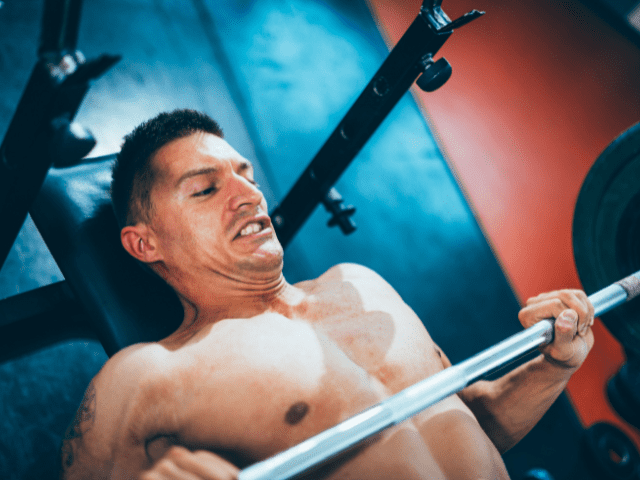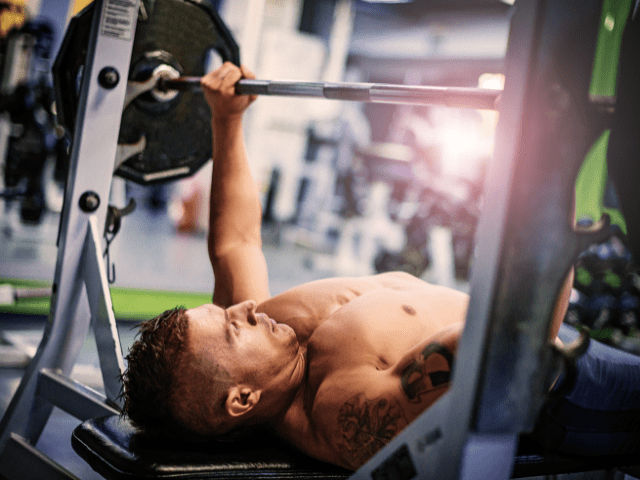Close Grip Bench Press vs Regular (What’s the Differences?)
Bench Press is one of the most popular and effective exercises for building upper body strength and muscle mass. However, there are different variations of the Bench Press that can target different muscle groups and provide unique benefits.
One of those popular variations is Close Grip Bench Press. Regular Bench Press involves a wider grip with the hands positioned outside of shoulder width, while Close Grip Bench Press involves a narrower grip with the hands positioned closer together.
Both variations are commonly used in strength training and bodybuilding programs, but is one better than the other?
This quick guide will compare Close Grip Bench Press vs. Regular Bench Press, examining the differences, benefits, drawbacks, and overall effectiveness of each exercise for building upper body strength and muscle mass. By understanding the nuances of each variation, you can choose the one that best fits your training goals and preferences.
Close Grip Bench Press

Equipment Needed
- Multi-purpose lifting rack
- Bench
- Barbell
- Bumper or Iron plates
Step-by-Step Instructions
- Set the height of the barbell so that when you unrack the barbell, you are only doing a very short upward concentric movement.
- Lie flat on your back on the bench.
- Keep your feet flat on the floor. (Some do find it comfortable to pull the feet back toward their butt as they arch).
- Keep your butt on the bench.
- Pull your shoulder blades together and keep the back of your head on the bench. You will slightly arch your back. Keep your core tight and keep the shoulder blades pulled back tight.
- Take a narrow grip, right at the start of the knurling and completely close your grip. Keep your knuckles pointing toward the ceiling and squeeze the barbell.
- Unrack the weight and take a deep breath.
- Control the barbell down during the eccentric movement and draw the barbell in, keeping the elbows tight to the body.
- The barbell will make contact with your torso right at the nipple line on the chest.
- Once contact is made, drive the barbell back up to the starting position.
Coaching Points
In regards to your setup and form; treat every rep like it’s a 1 rep max. Put a tremendous amount of detail in your setup (Do it the exact same way, every rep).
Make small gains in weight over time.
RELATED –> my 10 best Close Grip Bench Press alternatives
Common Mistakes
- Do not overarch the back or let your butt come off the bench.
- Do not let the back of your head come off the bench because you are pulling down on your neck to watch the bar hit your chest. You will get used to the movement and your peripheral vision will allow you to know when the bar makes contact.
- Do not let the elbows flare out away from the midline. The shoulders are incredibly vulnerable in these positions and the sheer force placed on the shoulders will lead to injury if the technique is not made a priority.
Benefits of Close Grip Bench Press
Here are a couple of benefits of the Close Grip Bench Press:
- Increased triceps strength: By using a close grip on the barbell, the Close Grip Bench Press emphasizes the triceps muscles more than a regular bench press would. This can help to increase triceps strength and mass.
- Improved chest and shoulder development: While the Close Grip Bench Press primarily targets the triceps, it also works the chest and shoulders. This can help to improve the overall development of these muscle groups.

Tired of coming up with your own workouts? But don’t want to pay an arm and a leg?
I post workouts 5 days a week right here. (Did I mention they’re free?)
Bench Press

Equipment Needed
- Multi-purpose lifting rack
- Bench
- Barbell
- Bumper or Iron plates
Step-by-Step Instructions
- Set the height of the barbell so that when you unrack the barbell, you are only doing a very short upward concentric movement.
- Lie flat on your back on the bench.
- Keep your feet flat on the floor. (Some do find it comfortable to pull the feet back toward their butt as they arch).
- Keep your butt on the bench.
- Pull your shoulder blades together and keep the back of your head on the bench. You will slightly arch your back. Keep your core tight and keep the shoulder blades pulled back tight.
- Take a thumbs-width grip from the knurling and completely close your grip. Keep your knuckles pointing toward the ceiling and squeeze the barbell.
- Later in this article, I will go over other popular grips and why they are used.
- Unrack the weight and take a deep breath.
- Control the barbell down during the eccentric movement and draw the barbell in, keeping the elbows at about a 45-degree angle away from the torso.
- The barbell will make contact with your torso right at the nipple line on the chest.
- Once contact is made, drive the barbell back up to the starting position.
Coaching Points
Remember why you are bench pressing. Goals matter. Make sure you are consulting with a coach or credible internet source so that you are engaging in beneficial bench press training for your future health and athletic success.
In regards to your setup and form; treat every rep like it’s a 1 rep max. Put a tremendous amount of detail in your setup (Do it the exact same way, every rep).
Make small gains in weight over time.
Common Mistakes
- Do not over arch the back or let your butt come off the bench. Most professionals will not accept repetitions if the butt comes off the bench but also you will likely injure yourself with poor form.
- Do not let the back of your head come off the bench because you are pulling down on your neck to watch the bar hit your chest. You will get used to the movement and your peripheral vision will allow you to know when the bar makes contact.
- Do not let the elbows flare out away from the midline. The shoulders are incredibly vulnerable in these positions and the sheer force placed on the shoulders will lead to injury if the technique is not made a priority.
Grips
Close grip: This grip may be used to train the bench press with an emphasis on tricep development. By bringing the grip in, the chest and shoulder musculature is not stretched as much.
Wider grips: This grip may be used to train the bench press with an emphasis on chest development. I do not recommend this grip for athletes and especially for those with a history of shoulder injuries.
Bench Press Benefits
Some of the benefits of Bench Press include:
- Improved upper body strength: The bench press is an effective way to build strength in the chest, triceps, and shoulders. By lifting progressively heavier weights, you can continuously challenge these muscle groups and see improvements in your strength and muscle size over time.
- Improved athletic performance: The Bench Press is a compound exercise that involves multiple joints and muscle groups. As a result, it can help to improve overall upper body strength and power, which can be beneficial for athletes in sports that require upper body strength and explosiveness, such as football or basketball.
- Increased bone density: Resistance training exercises like the Bench Press can help to increase bone density, which can be particularly beneficial for women as they age and their risk for osteoporosis increases.
Close Grip Bench Press vs Regular: Which is Better?
Now, let’s take a side-by-side look at the two bench press variations and discuss if one is better than the other for some common lifting goals.
Better For Developing Strength and Size: Bench Press
Overall, Bench Press is the better of the two exercises for increasing strength and building mass. There are a few clarifications that need to be made though.
First, both exercises are excellent at developing both strength and hypertrophy. So, by no means does saying one is better to mean the other isn’t good.
Second, it does depend a little on what your focus is. Close Grip Bench Press really targets and emphasizes the triceps, more so than a regular Bench Press. So, if your goal is to specifically develop triceps strength and size, then the answer would actually be Close Grip Bench Press.
Having said that, Bench Press is one of the most effective upper-body exercises one can do for both strength and size. It’s one of my favorite exercises for athletes of many different sports.
Better For Beginners: Bench Press
When I’m programming for beginners I want to keep exercises safe, easy to learn and easy to execute. I believe that both of these exercises check all three of those boxes IF the focus is on proper technique and the weight used is appropriate. Always start light and then gradually increase once technique becomes proficient.
So, why do I give the edge here to Bench Press?
Because I think Bench Press is the more fundamental of the two movements and can provide more value to a beginner first starting out. A beginner will see a tremendous amount of gains if they consistently stick with basic compound exercises.
Once they’ve built a good base of strength (and technique) then I would suggest branching out into other Bench Press variations.

Get Shredded… For Free
Get a free workout Monday through Friday, posted right here on Horton Barbell. These workouts are designed to help you get strong, in shape and look great at the beach!
Final Thoughts
I’ve just spent the last section of this article comparing which is better – Close Grip Bench Press or Regular Bench Press. The truth is, there is no reason to not have both exercises in your strength program.
Both exercises are extremely effective at developing upper-body strength. And, by incorporating both exercises periodically in your long-term strength plan you can add variety to your workouts and keep them from getting stale.
So, my suggestion is instead of trying to decide between these two movements, figure out how you can utilize both Close Grip Bench and regular Bench Press in your workouts.
More Links and Info
Check out how Bench Press stacks up against some other popular upper-body movements:

